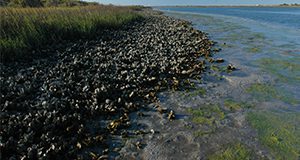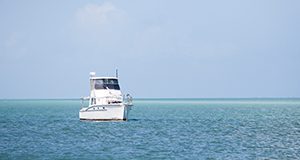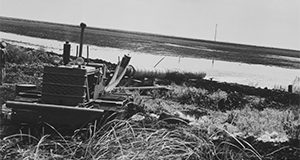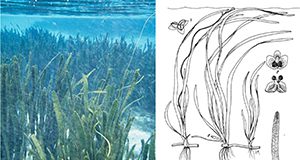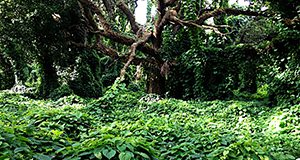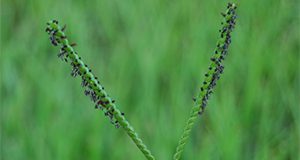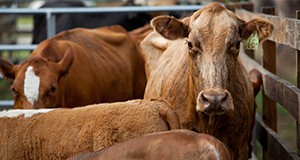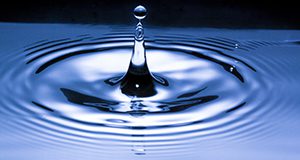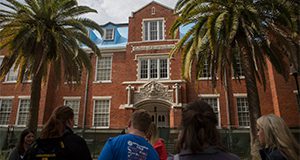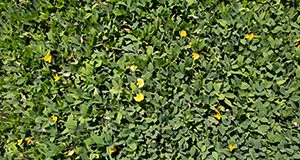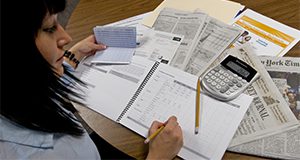This 10-page document is the eleventh lesson in the Cetaceans 4th Grade Curriculum. It contains information that will help students learn about North Atlantic right whale life history. Written by Ruth Francis-Floyd and Maia Patterson McGuire, and published by the UF/IFAS Veterinary Medicine–Large Animal Clinical Sciences Department, June 2019.
http://edis.ifas.ufl.edu/vm236
Author: Amanda Quintos
Identificacion del Estres Termico en Vacas Lecheras
El estrés térmico ocurre cuando el calor producido por los procesos biológicos y el calor absorbido del ambiente excede la capacidad de la vaca para perder calor. This 2-page document is the Spanish version of AN356, Recognizing Heat Stress in Dairy Cows. Written by Izabella Toledo and Geoffrey Dahl, and published by the UF/IFAS Department of Animal Sciences, October 2019.
http://edis.ifas.ufl.edu/an358
Cetaceans 4th Grade Curriculum: Lesson 14: How Do Right Whales Communicate?
This 3-page document is the fourteenth lesson in the Cetaceans 4th Grade Curriculum. It contains information that will help students learn how baleen whales use sound to communicate, and how human-created noise in the ocean may affect their ability to do so. Written by Maia Patterson McGuire and Ruth Francis-Floyd, and published by the UF/IFAS Veterinary Medicine–Large Animal Clinical Sciences Department, June 2019.
http://edis.ifas.ufl.edu/vm239
Cetaceans 4th Grade Curriculum: Lesson 17: How Can We Reduce Threats to North Atlantic Right Whales?
This 13-page document is the seventeenth lesson in the Cetaceans 4th Grade Curriculum. It contains information that will help students learn about ways to minimize ship strikes and whale entanglements. Written by Maia Patterson McGuire and Ruth Francis-Floyd, and published by the UF/IFAS Veterinary Medicine–Large Animal Clinical Sciences Department, June 2019.
http://edis.ifas.ufl.edu/vm242
Cetaceans 4th Grade Curriculum: Lesson 10: Summarizing What We Know about Cetaceans
This 5-page document is the tenth lesson in the Cetaceans 4th Grade Curriculum. It contains information that will help students learn about different types of poetry and write poems to express what they know about whales and dolphins. Written by Maia Patterson McGuire and Ruth Francis-Floyd, and published by the UF/IFAS Veterinary Medicine–Large Animal Clinical Sciences Department, June 2019.
http://edis.ifas.ufl.edu/vm235
Cetaceans 4th Grade Curriculum: Lesson 18: Bringing It All Together
This 6-page document is the eighteenth lesson in the Cetaceans 4th Grade Curriculum. It contains information that will help students develop persuasive essays and corresponding presentations about North Atlantic right whales. Written by Maia Patterson McGuire and Ruth Francis-Floyd, and published by the UF/IFAS Veterinary Medicine–Large Animal Clinical Sciences Department, June 2019.
http://edis.ifas.ufl.edu/vm243
Cetaceans 4th Grade Curriculum: Lesson 15: Technology and North Atlantic Right Whales
This 6-page document is the fifteenth lesson in the Cetaceans 4th Grade Curriculum. It contains information and activities that will help students learn the ways that technology is being used to study North Atlantic right whales. Written by Maia Patterson McGuire and Ruth Francis-Floyd, and published by the UF/IFAS Veterinary Medicine–Large Animal Clinical Sciences Department, June 2019.
http://edis.ifas.ufl.edu/vm240
Cetaceans 4th Grade Curriculum: Lesson 5: Scientific Names: Understanding Where Those Funny Words Come from
This 7-page document is the fifth lesson in the Cetaceans 4th Grade Curriculum. It contains information and activities that will help students interpret the scientific names of certain whales and dolphins. Written by Maia Patterson McGuire and Ruth Francis-Floyd, and published by the UF/IFAS Veterinary Medicine–Large Animal Clinical Sciences Department, June 2019.
http://edis.ifas.ufl.edu/vm230
Rice Physiology, Products, and Critical Steps Associated with Postharvest Operations in Southern Florida
This 5-page document pertains to the UF/IFAS Extension programs related to rice production in the EAA and focuses on the steps that comprise postharvest processing of rice (drying, tempering, milling, and storage). It aims to highlight the physiology of the rice kernel and define some of the common terms used in the rice industry, elaborate on the steps in postharvest processing, and provide a brief overview of rice products and their market potential. Written by Jehangir H. Bhadha, Sangeeta Mukhopadhyay, Charlene Andrews, and Matthew VanWeelden, and published by the UF/IFAS Agronomy Department, September 2019.
http://edis.ifas.ufl.edu/ag438
Tapegrass, Eelgrass, or Wild Celery (Vallisneria americana Michaux): A Native Aquatic and Wetland Plant
This 5-page document describes the main features of tapegrass and summarizes important habitat requirements for its growth and restoration. Written by Mohsen Tootoonchi, Lyn A. Gettys, and Jehangir H. Bhadha, and published by the UF/IFAS Agronomy Department, September 2019.
http://edis.ifas.ufl.edu/ag437
Lost in the Weeds?: A Comprehensive Guide to Florida's Many Non-Native Plant Lists
Because researchers and land managers in Florida have been dealing with invasive species for decades, there is an abundance of resources available to the public regarding invasive species. Sometimes, the volume of available information can be confusing. This 6-page document aims to inform the general public, land managers, researchers, local and state policy makers, and others who seek guidance in accessing regulatory and nonregulatory non-native plant lists in the state of Florida. This publication explains the origins of the lists, meaning of inclusion on a particular list, and ways to access each of the lists. Written by Deah Lieurance and Lyn A. Gettys, and published by the UF/IFAS Agronomy Department, August 2019.
http://edis.ifas.ufl.edu/ag436
Risk Management Planning for Agricultural Business Owners
Risk identification is the beginning point for risk management planning because solution identification begins with knowledge of the problem. This 4-page document presents questions to consider regarding production risk, price or market risk, financial risk, legal risk, and human risk. Written by Martie Gillen and Beatrice Pierre, and published by the UF/IFAS Department of Family, Youth and Community Sciences, August 2019.
http://edis.ifas.ufl.edu/fy1485
The Value of Tropical Plant Diversity
This new 5-page document discusses plant diversity at the UF/IFAS Tropical Research and Education Center, environmental factors and human activities affecting these plants, assemblages of species based on levels of disturbance, human choice, and other factors, and the diverse needs these plants meet. Written by Cliff G. Martin and Zachary T. Brym, and published by the UF/IFAS Agronomy Department, June 2019.
http://edis.ifas.ufl.edu/ag435
Bahiagrass (Paspalum notatum Flueggé): Overview and Pasture Management
This 10-page document discusses bahiagrass forage cultivars, forage production, nutritive value, animal performance, planting, pasture renovation, management, and more. Written by Marcelo Wallau, Joao Vendramini, José Dubeux, and Ann Blount, and published by the UF/IFAS Agronomy Department, revised July 2019.
http://edis.ifas.ufl.edu/ag342
Estimating Herbage Mass on Pastures to Adjust Stocking Rate
This new 6-page document explains methods to measure forage mass and utilize that information to estimate an adequate stocking rate. Written by Jose Dubeux, Marcelo Wallau, João Vendramini, Liliane Silva, Jane Griffin, Nicolas DiLorenzo, and Erick Santos, and published by the UF/IFAS Agronomy Department, June 2019.
http://edis.ifas.ufl.edu/ag434
Design and Construction of a Constant Head Infiltrometer
This new 8-page document details the construction procedure for a Mariotte siphon constant head infiltrometer using readily available materials. Written by Mahesh Bashyal, Michael J. Mulvaney, and Eban Z. Bean, and published by the UF/IFAS Agronomy Department, June 2019.
http://edis.ifas.ufl.edu/ag433
Strategies to Fund Your Child’s College Education: Using Savings and Tax-Advantaged Vehicles
It is never too soon to explore funding options for college educations, whether your child is a newborn or is in middle school. You are more likely to be prepared to fund your child's education if you start planning earlier. This new 4-page document describes and discusses several accounts that allow you to pay for college while taking advantage of tax and savings opportunities. Written by Jessica McCumber, Jorge Ruiz-Menjivar, Martie Gillen, and Sarah M. Ellis, and published by the UF/IFAS Department of Family, Youth and Community Sciences, June 2019.
http://edis.ifas.ufl.edu/fy1484
Methods of Forage Moisture Testing
Determining forage moisture is an essential procedure for estimating forage mass in pastures, determining harvesting or baling point for preserved forages, and calculating dry matter of feedstuff for total mixed rations. This 3-page document discusses methods and pieces of equipment available to estimate forage moisture. Written by M. Wallau and J. Vendramini, and published by the UF/IFAS Agronomy Department, revised June 2019.
http://edis.ifas.ufl.edu/ag181
An Overview of Risk Management Planning
As risks evolve and diversify, approaches to conducting business require a targeted focus on risk management, particularly in agriculture. This new 3-page document explores risk in agriculture, the need to understand risk, formation of strategies to manage risk, and government programs that exist to help growers and producers manage risk. Written by Martie Gillen and Beatrice Pierre, and published by the UF/IFAS Department of Family, Youth and Community Sciences, May 2019.
http://edis.ifas.ufl.edu/fy1482
Major Asset Classes: A Brief Glossary
The best time to have started investing is yesterday. This new 2-page document aims to provide a brief but comprehensive glossary of the main financial investment vehicles. Written by Jarrett Tsai, Jorge Ruiz-Menjivar, and Martie Gillen, and published by the UF/IFAS Department of Family, Youth and Community Sciences, May 2019.
http://edis.ifas.ufl.edu/fy1483
